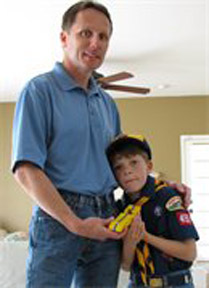Approximately 80 percent of what we learn comes through the visual system. Parents can best support their baby’s vision when they understand the sequence of visual development.
• The visual system is the least developed of all the senses at birth, but it improves throughout the first six months of life.
• The major period of visual development takes place between birth and age 2.
• The eye increases to three times its size at birth, and growth is completed by age 3.
• At birth, babies will begin using their eyes, muscles, and the brain to develop visual skills. Brain development is strengthened by interaction with the environment.
Your baby’s first visit to your doctor of optometry for a comprehensive eye assessment should be scheduled before 12 months. The optometrist will test for visual acuity, excessive or unequal amounts of nearsightedness, farsightedness, or astigmatism, evaluate eye alignment, and examine how the eyes work together. The health of your baby’s eyes will be assessed as well. Vision problems occur in about 20 percent of kids and it is important to identify children who have specific risk factors at this stage. Vision development and eye health problems can be more easily corrected if treatment is begun early.
Also, parents can promote healthy visual development, by learning how, when and what to provide to help their baby’s vision develop properly.
Birth to 4 months
• Provide enough light for the baby to see things clearly when he is awake and alert.
• Keep the room dark when the baby is asleep
• Keep soft toys within 8-12 inches for reaching and touching.
• Talk to and look at the baby as he is carried around the room or the house.
• Have simple shapes with contrasting colors in the baby’s environment.
• Provide high-contrast colorful or black and white mobiles within the baby’s visual range, as well as an unbreakable mirror.
• Safely attach a mobile or crib gym for the baby to grab, pull and kick. Remove it before the child is able to push up on his hands and knees.
5 to 8 months
• Have the baby spend plenty of time exploring and playing on the floor.
• Provide plastic or wooden blocks that can be held in the baby’s hands.
• Play games like pat-a-cake, moving the baby’s hands through the motions.
9 to 12 months
• Help develop visual memory by playing hide and seek with toys or a parent’s face.
• Continue to identify specific objects when talking to the baby to help develop word association and vocabulary.
• Making sure that the environment is safe; give opportunities for crawling and creeping.
1 to 2 years
• Roll a ball back and forth with the toddler for developing tracking skills.
• Help develop fine motor skills by providing balls of different sizes and safe building blocks.
• Read and tell stories to help develop the child’s visualization skills, which lead to later reading skills.
2 to 3 years
• Read and talk about colorful children’s picture books.
• Have crayons and large paper available for scribbling and drawing.
• Provide matching and sorting activities.
• Help with simple puzzles.
For more information about your child’s vision please visit http://infantsee.org
Dr. Redman and his family have lived in Hollister since 1999. He has one son who attends elementary school in the Hollister School District. Dr. Redman has owned and operated a private optometric practice for the past 16 years.










